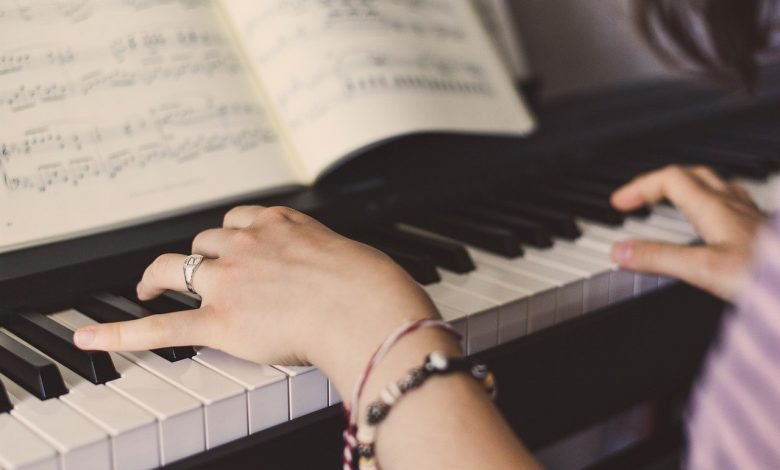How to Improve Piano Hand Coordination

“It’s like the orchestra, the piano for me”-perfectly summed up the myriad of emotions expressed through those black and white keys when played to perfection. To achieve this perfection, one needs piano lessons from our expert piano instructors at Mississauga Piano Studios in Brampton. Learn from the best and get lost in the harmonious world of piano music.
Tips for hand coordination for beginners
- As a beginner, you have to learn to read music first, and then be proficient in understanding the bass, the toned clef simultaneously. You need a thorough knowledge of music theory, coordination of both hands, voice leading, and harmony.
- Begin with mastering scales and then start playing scales in patterns. Such as practice playing scales in 3rds, 4ths, and 5ths in both ascending and descending order.
- Practice playing the full range of the instrument by playing the scales and patterns. You can start with one octave, then two, and then so on until scales are fluid over the range of the instrument.
- To practice coordination, put the left hand in the lead by pressing keys with the right hand lightly and the keys with the left deeply. This will provide a powerful baseline, once you master this, take the left hand down an octave to make sure you are playing two scales apart.
- Finally, slowly and steadily, lighten your touch and speed.
How to de-stupefy the left hand
Beginners may notice that while playing songs, the right hand is in charge of the melody and the left is playing back-up. To improve both hands’ synchronicity, our piano instructor Brampton teaches some exercises to de-stupefy your left hand:
- Finger lifts: This step can be done without a piano. Gently put your hands on a smooth surface and gently press your thumb (finger 1) up to the pinky (finger 5) one by one and back. Fingers 4 & 5 are differently connected than others, so it’s difficult to raise them individually. Practicing this increases fingers’ dexterity and makes the connection between fingers and your brain strong.
- Octave scales: Our piano instructor Brampton teaches the octave technique in which we encourage students to play the C scale ( only the white keys) efficiently. This may sound challenging, it requires consistency and practice. Keep your wrist elevated and fingers relaxed to play correctly.
- Playing the same note with both hands: In the next exercise, we suggest students play Scale C with the left hand and the octaves with the right.
- Switch it up: Once you master the previous exercise, play Scale C with your right hand and octaves with the left. We advise students to use the metronome to work up the speed as well.
- Trying different keys: During piano lessons, we suggest students try different key signatures- choosing their favorite scale and applying this routine. This will familiarize them with all the keys of the keyboard.
- Doing regular work with the left hand: If students are right-handed, they should do regular tasks like opening the door, brushing teeth, rotating the shower handle to de-stupefy the left hand.
What to do to play the piano with both hands
Our piano teacher Brampton in our piano School Brampton suggests that you need reassurance and the following tips to play with both hands:
- Practice tapping your hands to understand the rhythm better. If you don’t focus on the rhythm, it will be harder for you to combine the elements of both hands.
- Practice each hand separately to give attention to playing the melody on each hand efficiently.
- We advise students to know the song by heart so that they don’t have to multitask to look at the sheet music and play.
- Never give up. This is the first piece of advice we give to our students- playing the piano with both hands is one of the toughest skills to master. Keep going at it and you will master perfection.
Tips to improve hand coordination and muscle memory
- Start with the weak hand or left hand while learning to play a musical instrument. The weaker hand takes more time to get used to.
- While learning to play the piano, tap out the quarter notes with the left hand, and the eighth note with the right, and vice versa. This method develops concentration with counterpoint and contrapuntal exercises.
- Quietly tap your fingers on a table to coordinate silently.
- Physically strengthen the weaker hand’s fingers with high-tech finger and hand strengtheners like Gripmaster, Power Putty, Fingerweights.
- Using the up & down method- putting both hands in a ready position, placing the left thumb on the C, and placing the fingers on either side of the C; play this scale with the right hand and the downscale with the left hand.
- Different scales and rudiments should be practised to coordinate hands at the beginning of practice as a warm-up.
- Using a metronome to control speed while playing scales and other exercises.
- To increase fine motor skills in fingers, press the keys slowly without looking at the fingers while playing the scales and feeling the touch of the keys.
Conclusion
To master playing the piano with both hands our piano teacher Brampton suggests the triple Cs- concentration, coordination, confidence. At Mississauga Piano Studios, the best music school in Brampton, we efficiently teach students the art of playing the piano and inspire them to strive for the musical epoch.



